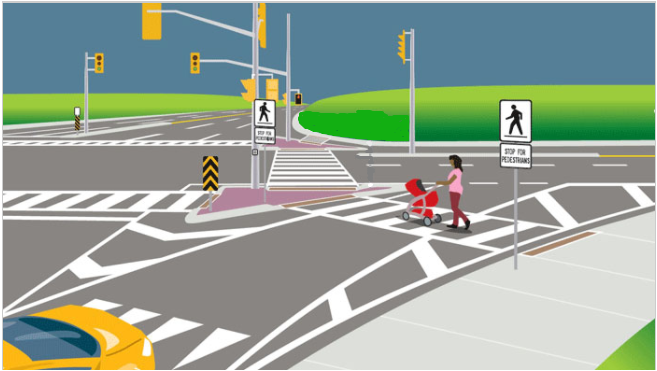On this page
Pedestrian crossings help you get from one side of the road to the other, but the type of crossing—crosswalk or crossover—affects how pedestrians and drivers should behave.
The biggest behaviour difference between crosswalks and crossovers is how long a driver must wait before proceeding through the crossing.
- Crosswalks: drivers must wait until pedestrians have cleared a portion of the roadway before proceeding, except when a crossing guard is present, then drivers must wait until the pedestrians and the crossing guard have cleared the entire roadway before proceeding.
- Crossovers: drivers must wait until pedestrians have cleared the entire roadway before proceeding.
How to spot a crossover
Crossovers have:
- Shark teeth (a line of white triangles painted on the road) that show where drivers should stop, and
- “Stop for pedestrians” signs on the roadside; signs may also include flashing lights and/or overhead signs

How crossovers work
Crossover rules and tips for pedestrians:
- If there is a push button for lights, press it to turn on the flashing lights before crossing
- Make it clear that you want to cross the road, make eye contact with drivers and cyclists so they see you
- Make sure drivers and cyclists have enough time to stop, and have fully stopped, before you start to cross
Crossover rules and tips for drivers and cyclists:
- Watch for pedestrians waiting to cross the road and make eye contact
- Stop for pedestrians at the yield line of white triangles
- Allow pedestrians to clear the entire roadway before proceeding to drive through (note that intersections with crossing guards require motorists and cyclists to wait until all pedestrians and the crossing guard have cleared the entire roadway before driving through)
- Do not pass other vehicles within 30 metres of the crossover
- Cyclists who wish to use the crossover to cross the roadway must dismount and walk their bike
Smart channels
Smart channels are an alternative design for channelized right turn lanes. Approaching vehicles must yield to pedestrians who are using the crossover and wait until they have fully crossed to or from a pedestrian island before proceeding. Smart channels prioritize pedestrian safety and provide improved traffic flow for drivers. Installing smart channels will:
- Improve visibility of pedestrians
- Reduce vehicle speeds for drivers making right turns
- Reduce the angle of shoulder check for drivers

Penalties for drivers
You can be fined of up to $1,000 and get four demerit points for failing to yield at pedestrian crossovers.
How we select locations for crossings
We follow provincially accepted guidelines when deciding where to put pedestrian crossings, and which style of crossing to use.
When a new request for a pedestrian crossing is submitted to us, we schedule a traffic study to collect pedestrian and traffic volumes. This information lets us know if a crossing is needed. We then decide which type of crossing should be used based on how many lanes the road has, the posted speed limit and traffic volumes.
Request a pedestrian crossing
Think a road could use a pedestrian crossing? Let us know by emailing us at [email protected] or calling us at 519-822-1260 extension 3414 with the following information:
- Your name
- Your phone number or email address
- The location you think needs a pedestrian crossing (e.g. Memorial Avenue at Goldie Crescent or Hands Drive near the MacAlister Park)
For more information
Traffic Services
[email protected]
519-822-1260 extension 3414
